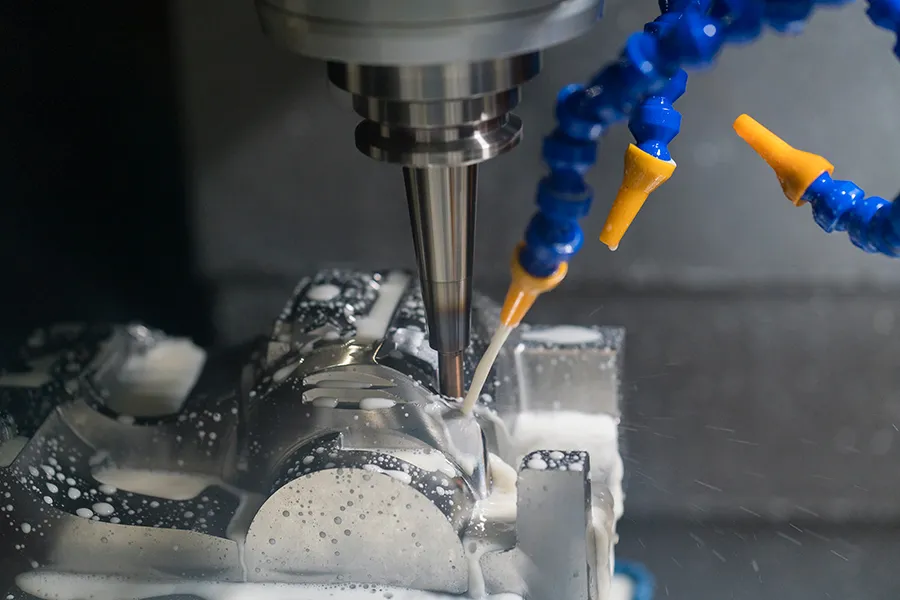CNC machining ABS (Acrylonitrile Butadiene Styrene) is a common and widely used process in the manufacturing of various parts and components. ABS is a thermoplastic polymer known for its good mechanical properties, impact resistance, and ease of processing. Here are some key considerations when CNC machining ABS:
- Material Selection: ABS is available in different grades and formulations. It’s important to choose ABS specifically designed for CNC machining to ensure optimal results. Standard ABS grades, ABS/PC blends, or specialized machining grades can be used depending on the specific requirements of the part.
- Machine Setup: Set up the CNC machine with the appropriate tooling and cutting parameters suitable for ABS machining. ABS is relatively soft compared to metals, so the machine settings should be adjusted accordingly to avoid excessive heat generation, melting, or deformation during the machining process.
- Cutting Tools: Select appropriate cutting tools designed for machining plastics or specifically for ABS. Carbide or high-speed steel (HSS) tools with sharp cutting edges and low rake angles are commonly used. It’s important to use proper tool geometry and sharp tools to ensure clean cuts and minimize the risk of melting or burrs.
- Machining Techniques: CNC milling and turning are the primary machining techniques used for ABS. These operations involve removing material to create the desired shape, features, and dimensions. Techniques such as climb milling and continuous cuts can help minimize heat buildup and reduce the likelihood of part deformation.
- Coolant and Lubrication: ABS machining typically does not require coolant or lubrication. However, a mist of cool air or compressed air can be used to help dissipate heat during the machining process and prevent the accumulation of chips.
- Dust Collection: ABS machining can generate fine plastic particles or dust. Proper dust collection or local exhaust ventilation systems should be employed to maintain a clean working environment and prevent the inhalation of airborne particles.
- Post-Machining Operations: After CNC machining, deburring, cleaning, and surface finishing operations may be necessary to remove any sharp edges or tool marks, improve aesthetics, and achieve the desired surface quality.
It’s important to note that ABS has a relatively low melting temperature compared to some other plastics, so careful attention should be paid to tool selection, feed rates, and cutting speeds to prevent overheating and melting. Proper machine setup, tooling, and machining techniques can result in precise and high-quality ABS parts in CNC machining processes.
ABS characteristics
ABS (Acrylonitrile Butadiene Styrene) is a thermoplastic polymer known for its desirable characteristics and wide range of applications. Here are some key characteristics of ABS:
- Strength and Impact Resistance: ABS exhibits good mechanical strength and impact resistance, making it suitable for applications that require durability and toughness. It can withstand moderate to high levels of external forces and impacts without fracturing or breaking easily.
- Rigidity and Stiffness: ABS has a relatively high rigidity and stiffness, providing structural integrity to parts and components. It maintains its shape and dimensional stability even under load or stress, making it suitable for applications where stability and stiffness are important.
- Chemical Resistance: ABS demonstrates resistance to a wide range of chemicals, including acids, alkalis, oils, and various solvents. It is less prone to chemical degradation or corrosion, allowing it to maintain its physical properties when exposed to chemical substances.
- Thermal Stability: ABS exhibits good thermal stability, with a melting temperature typically ranging from 210°C to 240°C (410°F to 464°F). It retains its shape and mechanical properties within a wide temperature range, making it suitable for applications that require resistance to temperature variations.
- Electrical Insulation Properties: ABS has excellent electrical insulation properties, making it a preferred choice for electrical and electronic applications. It provides electrical insulation and can withstand moderate voltage levels without conducting electricity.
- Ease of Processing: ABS is easy to process through various manufacturing techniques, including injection molding, extrusion, and CNC machining. It has good flow characteristics when heated, enabling it to fill molds and create complex shapes with relative ease.
- Surface Finish and Aesthetics: ABS can be easily finished, painted, or decorated. It has a smooth surface that can be polished, sanded, or textured to achieve the desired aesthetic appearance.
- Availability and Affordability: ABS is readily available in the market and is relatively cost-effective compared to some other engineering-grade thermoplastics. Its affordability, combined with its desirable properties, makes it a popular choice in various industries.
Due to its versatility and combination of properties, ABS finds applications in numerous industries, including automotive, consumer goods, electronics, appliances, toys, and more. Its strength, impact resistance, rigidity, and ease of processing make it a versatile material for a wide range of applications.

